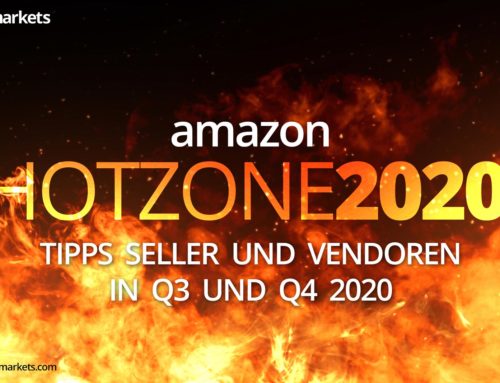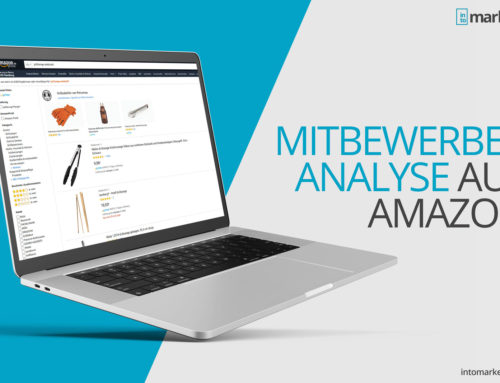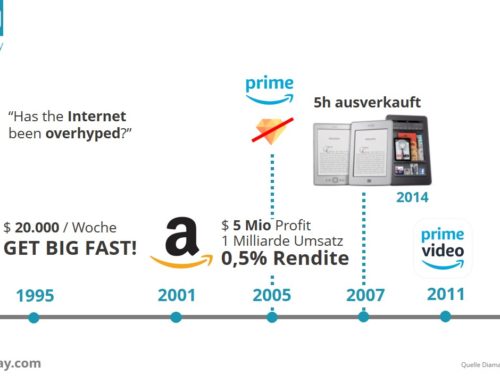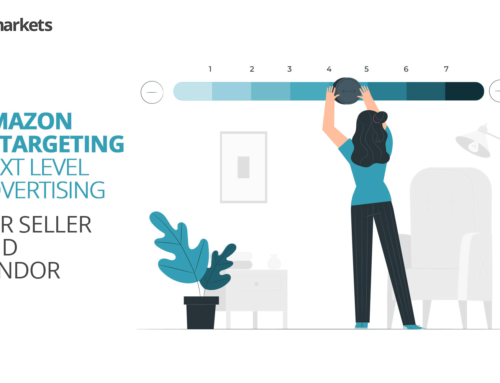What Is Actually Branding?
Whenever a brand is to be established or strengthened in a particular “ecosystem”, “branding” is quickly mentioned. In essence, this is always based on the idea that a brand should become better known and thus serve a higher demand. Consequently, where there is a high demand, there is a high chance of sales and turnover and this is exactly what almost all commercially oriented companies aim for. So if you manage to increase your brand awareness, you can also earn more money – this is the theory because the practice often looks different and needs to be considered in a more diversified way. Especially when it comes to the Amazon Marketplace, branding is only possible to a limited extent, or in the theoretical (marketing) approach is necessary.

Is branding possible with and on Amazon?
As a specialized Amazon marketing agency, we always have to deal with the crucial question at the beginning of a customer relationship: What do we actually want to achieve on Amazon? Do we want to boost our sales or increase our brand awareness? The answer is almost always: Best of all, both! If possible, both goals should then be paid from the same pot and be served with the same resources, but this is only possible to a limited extent. But sometimes it does work if the conditions are right.
Let us briefly clarify the question of what “branding” means from a marketing perspective. Clear answer: To be visible as often as possible in the focus of potential buyers. If we talk about “visibility” specifically in the Amazon cosmos, the success of the branding could be measured by the impressions. So far so irrelevant, because impressions alone do not earn you money if you would think with the glasses of sales or product management. Here, branding can also be looked at recursively, because if the product is sold more often, this is after all also a form of branding, since it is circulated more often and can therefore also achieve potentially higher visibility.
Why am I on Amazon?
Let’s get back to the starting point: What do customers do on Amazon? Why do they move on this platform? Clear and undisputed answer: They want to buy. This makes Amazon Marketplace primarily a sales channel. Fullstop! Theoretical branding based on impressions is rather out of place here. Sales and product management will now feel confirmed. If I now plan my marketing measures with a concrete reference to the marketplace, every action must at least in the end be sales-oriented, because otherwise, I miss my target group. This is exactly where Amazon Advertising, especially PPC-based advertising, fits perfectly into this strategy. Users are interested in a product or a brand (or both), search for it and get exactly the right advertisement (at least in theory). So I use performance marketing ads to connect demand with supply and direct users to the exact goal: buying a product.
At this point, you could stop the plan because that’s what PPC on the Amazon marketplace is for. But it’s not quite that simple, because I can’t ignore the theoretical approach of branding here. Theoretically, this means: generate as many impressions as possible to achieve high visibility and “better” branding. However, it would not be called “performance marketing” if the impressions alone were sufficient. In this case, performance means that the user is shown, clicked, and also bought. The “PPC tunnel” therefore looks like this:
- Impression = Ad was successfully played
- Click = aroused interest of buyers
- Sale = interest was served (user converted to buyer)
The (in)direct online and offline branding
Let’s go back to the beginning and ask ourselves the question what branding actually is. To keep it simple: Increase brand awareness. As already mentioned, in this context it is often “only” about increasing the visibility of a brand on the respective channels advertised. So if you massively increase the impressions, then in principle this means nothing else but that you are actively working on branding – more people see the advertisements and thus come into contact with the brand and the products associated with it. The marketing department would often already be satisfied with this and if you also follow the employees from the warehouse of the Amazon Media Group (AMG for short), then as many impressions as possible are per se a success. You should not pay attention to click rates, let alone sales transactions, because that is not the focus of branding. The “only” question that remains is whether many impressions actually have a downstream effect on sales. This is difficult to measure and sometimes cannot be depicted at all.
Let’s look at “branding” the other way round because you could quickly come to the conclusion (if you wear sales glasses) that the impressions are not worth much. In fact, this key figure is also very important in performance marketing, because without displaying or playing my ads, no clicks, and consequently no sales can be achieved. Many impressions also mean that many people theoretically see my ads and therefore also my products. If the PPC campaigns are set up “cleanly” and also achieve many clicks, then this also increases the sales probability enormously. Consequently, the advertising I place here and the budget I invest is targeted at sales with a high probability of closing. You could also call it a bit of “effective branding“, which fits perfectly into the basic concept of the Amazon marketplace: I do not want to be inspired; I want to buy!
Impressions are also important in performance marketing
So if we now assume that with well-structured PPC campaigns, a sufficient advertising budget and a strong brand, we manage to create a lot of impressions in performance marketing and generate a lot of sales at the same time, there is another side effect that many online marketers like to forget or don’t even have on their screens: The indirect branding that is generated by the pure sale of the goods and the associated radiance in the offline world. In concrete terms, this means: If I sell many products through Amazon Advertising, for example, all buyers theoretically become my micro-brand ambassadors. After all, they walk around “out there” with the products and make sure that my brand becomes better known here as well. Simple conclusion: The more products are in circulation, the greater the branding effect. Only with the decisive difference that here, too, really measurable sales and not just statistical impressions were generated.
A small, personal example: About 2 years ago I decided to buy a Smartwatch. A few weeks later I was sitting next to a friend at a conference with the new gadget on my wrist. He looked curiously at the watch because unlike other Smartwatches, this one had a round display for the first time. This enthused him so much that he decided to buy exactly the same model just one day later and ordered it directly from Amazon. I actually became aware of this watch through a PPC campaign, because I was very involved with the watch market at that time due to a private project. If I hadn’t seen the ad, I might never have bought this Smartwatch and also my friend might never have chosen this model. I became a micro brand ambassador through advertising (and consumption). The winners, in this case, were Amazon as an advertising platform and Samsung as a manufacturer.
Display marketing vs. performance marketing – which form of advertising is better?

Man muss kein eingefleischter Werbeprofi sein, um zu erkennen, dass Performance-Marketing definitiv verkaufswirksamer als das rein auf Impressions-basierte Display-Marketing ist. Wenn es also um die gezielte und maximal mittelfristige Umsatzsteigerung geht, dann sollte Performance zweifelsohne der präferierte Kanal für das Werbebudget sein. Betrachtet man das Ganze allerdings nur isoliert, dann bekommt man möglicherweise ein langfristiges Problem, denn Display-Marketing ist nicht nur Branding und hat definitiv seine Daseinsberechtigung und Wichtigkeit. Bleiben wir für eine Erklärung bei Amazon, denn hieran kann man die Bedeutung von Display- und Performance-Marketing sehr gut erklären.
Investiert man sein gesamtes Marketing-Budget ausschließlich in verkaufsorientiertes Performance-Marketing, dann erreicht man ausschließlich die Kunden, die konkret nach einem bestimmten Keyword oder einer Marke suchen. Außer Acht lässt man die Nutzer, die vielleicht sogar ein sehr großes Kaufinteresse haben, aber das Produkt noch gar nicht kennen und demzufolge danach gar nicht aktiv suchen. Außer Acht lässt man die Nutzer, die noch gar nicht wissen, dass sie ein bestimmtes Produkt brauchen könnten und folglich ebenso wenig über Performance-Marketing erreicht werden können. In beiden Fällen muss erst ein gewisses Produktbewusstsein oder Markenbewusstsein geschaffen und damit auch ein Kaufverlangen ausgelöst werden. Und genau hier kommt das Display-Marketing ins Spiel, denn hiermit erreicht man genau die Nutzer, die noch unentschlossen oder sich ihres Bedürfnisses noch gar nicht bewusst sind.
Beispiel: So kann Display-Marketing bei Amazon funktionieren
 Das klingt vielleicht jetzt noch sehr theoretisch – werden wir praktischer und hangeln uns an einem kleinen Beispiel durch. Nehmen wir an, ein Kunde ist passionierter Heimwerker und kauft sich entsprechendes Equipment dafür regelmäßig auf Amazon. Ein Werkzeughersteller bringt eine völlig neuartige Nagelpistole auf den Markt, für die sich theoretisch auch unser Heimwerker interessieren könnte. Das Problem: Genau dieser Kunde hat sich erst vor kurzem einen neuen Hammer und ein umfangreiches Nagelset bestellt. Sein Bedarf konkret in diesem Bereich ist jetzt erst einmal gedeckt und er würde nicht aktiv mit diesem Fokus „Werkzeug für Nägel & Co.“ suchen. Jetzt könnten man bspw. über Cross- und Upselling-Ideen und clevere Kampagnen-Strukturen zwar versuchen, ihn dennoch auf die neue Nagelpistole zu bringen, aber die Streuverluste und damit auch das Werbe-Investment sind jetzt erst einmal recht hoch. An dieser Stelle könnte Display-Marketing (z.B. Amazon DSP) mit einem spitzen Zielgruppen-Targeting ins Spiel kommen. Mit dem Fokus auf Männer im Alter zwischen 40 und 60, Heimwerker-Interesse, Eigenheimbesitzer und einem etwas überdurchschnittlichem Grundeinkommen könnte hier ein guter Ansatz für das Targeting sein. Speziell auf Heimwerker-nahen Websites wird nun die Nagelpistole präsentiert. Ohne konkret danach gesucht zu haben, können genau so ein Bedürfnis und ein Verlangen danach aufgebaut werden.
Das klingt vielleicht jetzt noch sehr theoretisch – werden wir praktischer und hangeln uns an einem kleinen Beispiel durch. Nehmen wir an, ein Kunde ist passionierter Heimwerker und kauft sich entsprechendes Equipment dafür regelmäßig auf Amazon. Ein Werkzeughersteller bringt eine völlig neuartige Nagelpistole auf den Markt, für die sich theoretisch auch unser Heimwerker interessieren könnte. Das Problem: Genau dieser Kunde hat sich erst vor kurzem einen neuen Hammer und ein umfangreiches Nagelset bestellt. Sein Bedarf konkret in diesem Bereich ist jetzt erst einmal gedeckt und er würde nicht aktiv mit diesem Fokus „Werkzeug für Nägel & Co.“ suchen. Jetzt könnten man bspw. über Cross- und Upselling-Ideen und clevere Kampagnen-Strukturen zwar versuchen, ihn dennoch auf die neue Nagelpistole zu bringen, aber die Streuverluste und damit auch das Werbe-Investment sind jetzt erst einmal recht hoch. An dieser Stelle könnte Display-Marketing (z.B. Amazon DSP) mit einem spitzen Zielgruppen-Targeting ins Spiel kommen. Mit dem Fokus auf Männer im Alter zwischen 40 und 60, Heimwerker-Interesse, Eigenheimbesitzer und einem etwas überdurchschnittlichem Grundeinkommen könnte hier ein guter Ansatz für das Targeting sein. Speziell auf Heimwerker-nahen Websites wird nun die Nagelpistole präsentiert. Ohne konkret danach gesucht zu haben, können genau so ein Bedürfnis und ein Verlangen danach aufgebaut werden.
Nochmal einen Schritt weitergedacht und frei nach dem Motto „wo gehobelt wird fallen Spänen“ lassen sich beinahe über selbes Targeting auch Blasenpflaster und Schmerzgels über Display-Marketing bewerben, denn Verletzungen sind auch bei talentierten Heimwerkern immer wieder an der Tagesordnung. Aktiv danach suchen würden sie vielleicht nicht. Wenn man Kunden aber auf die Idee bringt, weckt man damit auch ein Kaufinteresse, dass man nur über Performance-Marketing schwer bis gar nicht erreichen würde. Daher noch einmal kurz zusammengefasst:
Wann ist Display-Marketing sinnvoll?
- Der Kunde weiß noch nicht, WAS er eigentlich braucht oder haben will.
- Der Kunde weiß noch nicht, DASS er etwas braucht oder haben will.
- Das Verständnis oder das Bewusstsein für eine bestimmte Marke sind noch nicht vorhanden.
Eine konkrete Ausnahme gerade in Bezug auf Amazon DSP bildet das Retargeting, denn hier befinden wir uns zwar auch im Display-Marketing mit dem CPM-Abrechnungsmodell (Bezahlung nach Impressionen), aber bewerben Produkte dennoch sehr verkaufsfördernd. Eine Retargeting-Anzeige bekommt man schließlich nur dann zu sehen, wenn man bereits im Vorfeld wenigstens einmal dieses Produkt (z.B. auf Amazon) bewusst angeklickt hat. Eine grundsätzliche Brand Awareness oder Produkt-Awareness ist also bereits vorhanden und muss nicht bei null aufgebaut werden. Dennoch aber gilt: Branding nur mit Impressionen aber ohne Klicks liefert kein messbares Ergebnis und widerspricht dem, wofür der Amazon Marktplatz eigentlich steht: Verkaufen.












Leave A Comment